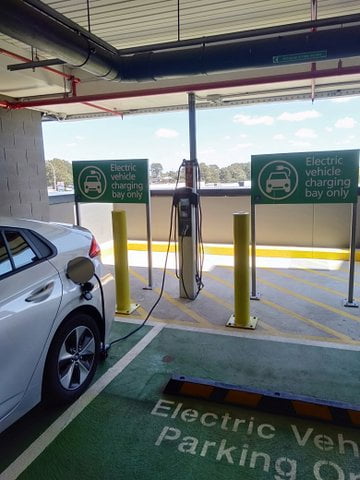Have your say on EV charging in Port Stephens
By Tim Meyer, Renew Hunter Region Branch.
Port Stephens Council currently has on exhibition, proposed changes to its Development Control Plan (DCP) to support future installation of Electric Vehicle Chargers in two specific scenarios: for residents in new apartment buildings, and for people using fast chargers at new commercial car parks such as shopping centres.

These changes ensure the Port Stephens DCP aligns with changes to the National Construction Code (NCC) that were implemented in October this year. Neither the NCC or the DCP require chargers to be installed, only to allow for their later installation by installing the necessary wiring and access in apartments, and by allocating 10% of spaces that can be retrofitted with fast chargers in commercial car parks.
You can find details on the DCP changes and how to comment here. Submissions close 13 November.
While these changes are welcome, they are a tiny step shuffle in solving the unanswered question of how our electricity network can handle a rapidly growing EV market in the most cost-effective way. Doing this will require some radical rethinking.
According to the Australian Energy Update 2023, just over 25% of Australia’s total energy consumption goes into transport – of which around half, or 12.5%, is used in light vehicles – mostly our cars. This compares to 8.5% of the total energy being used in our homes. Households can therefore expect to more than double electricity use as our cars move from petrol/diesel to electric.
Currently most EV charging is done at home, mainly overnight for people who use their car to go to work, with commercial ‘fast chargers’ for people travelling longer distances or who live in apartments. As we transition to EVs, serious consideration must be given to when and where these should be charged. While the current strategy of charging overnight at home works – for now – because we still have a surplus of coal generated electricity while we sleep, as coal fire power stations close and are replaced by solar and wind farms, we shift to cheaper surplus electricity during the day with expensive storage needed to provide electricity at night.
To reduce the need for additional generation from off-shore and outback wind farms and/or huge amounts of expensive grid based storage requires a major rethink on how we charge our EVs.
Neither the NCC or our local DCP have considered is the opportunity of having EVs charging during the day – in your work carpark or at a park-and-ride. This will be when electricity is cheapest and it will mean that in a few years time, most people can drive a fully charged ‘portable battery’ home, plug It in and use it to run their home through the evening peak electricity demand/price period.
What we need is a national plan, not just for EV charging, but for the overall energy transition.
Rewiring Australia’s Dan Cass says that under the previous federal government there was no clear national plan for the renewables transition. “That failure to have a sophisticated social and economic plan around the large-scale transition has put Australia in a very precarious place. Now we’re in a panic and doing catch-up.”
Don’t forget to have your say on Council’s DCP changes – you can find details and how to comment here. Submissions close 13 November.
